Behind the Scenes: Scenic and Costume Design of THE LION IN WINTER
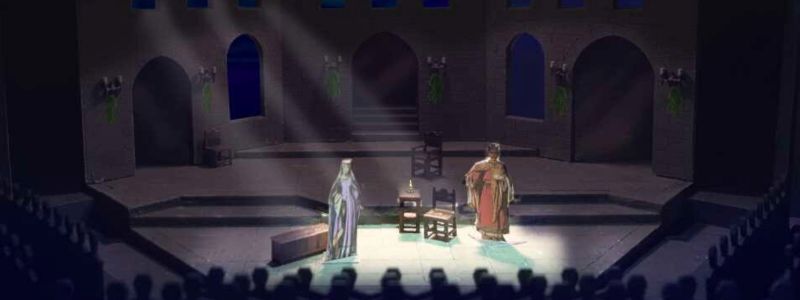
At first glance, the set and costumes of The Lion in Winter appear to be fairly simple: the play takes place in a castle and everyone is dressed in medieval garb. It would be easy to assume that these theatrical elements are drab or fade into the background, but that assumption could not be farther from the truth.
Scenic Designer Linda Buchanan and Costume Designer Christine Pascaul use their skillful, intricate, and effective designs to both elevate James Goldman’s classic tale and tell a story of their own. Here, Buchanan and Pascual take us behind-the-scenes, let us into their process, and show us how a play set in 1183 can be thrillingly modern.
Scenic Design
Linda: The Lion in Winter is such an incredible script. It’s so rich, so clever, and so sophisticated that it feels so odd that it takes place in the eleven-hundreds [laughs]. Ron [OJ Parson, Director and Court Resident Artist] was committed to keeping the look of the period, but laying a modern feeling over it.
There are a few reasons why its original time period is useful. First of all, the general historical events actually happened, and this is actually where they happened. The conflict for succession within this family was real. Also, in this original time period, castles were not pretty. Life was really hard. (To us, this looks pretty severe, but at the time, it was considered quite lovely for a castle.) Life was basic, hard, and a struggle, and political succession was not a given. There was the tradition of the oldest son succeeding the king, but that did not happen often. In fact, it often led to a bloody resolution. So there’s something to be said for anchoring this story in this world that’s a little more severe than what modern audiences might be used to.
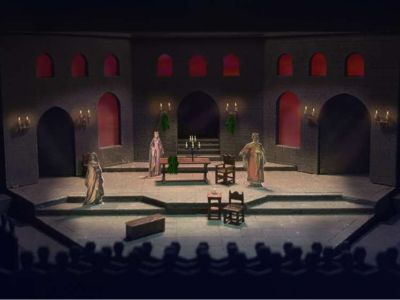
For example, it was interesting to learn that many castles at this time didn’t even have glass windows; most just had wooden shutters. Imagine how cold, damp, and primal that could make your life! All the lighting in the castle was from fire, or candles, or coals, so it was also pretty dark most of the time. So that’s the feeling we tried to capture in the set. The windows can be backlit – they have rear projection screens on them – so, sometimes, the windows and the lighting might be very emotional, or they might look like bars to symbolize a prison. They serve as a mood ring for the scene [laughs].
Something that we had to consider is the many different locations in this play, so we didn’t want to use a ton of moving scenery. We use a little bit, as you’ll see, but we kept it as stripped down and simple as possible. Any furnishings can move, and they’re really basic. We have a couple of tracking pieces – there’s a large bed with curtains that track in, and we also have a table that tracks in and out for some scenes.
On the whole, the set is very stripped down, and it relies heavily on lighting and movement to indicate when we’re in a different place. This is a simple design, but it gives the actors a blank canvas to play with, so we get to see what they do with it!
Costume Design
Christine: When Ron and I were talking about it, we talked about how this play is a period piece, but we don’t want it to be too period. We still want it to be modern-looking.
When we first meet King Henry, he’s in Alais’s chambers, so he’s just wearing a tunic, but later in the reception, he has a robe and crown. As you can tell from that example, the basic costume pieces are tunics. I wanted to have them longer – I didn’t want to see any tights [laughs] – and I wanted almost modern-looking boots and not a lot of trim.
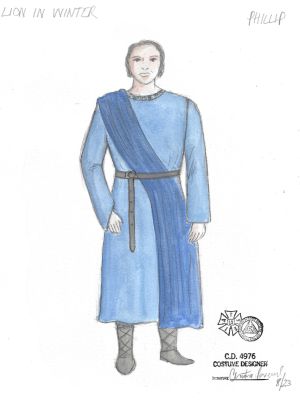
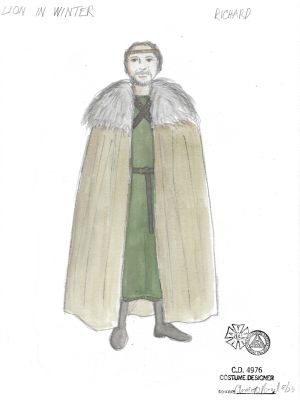
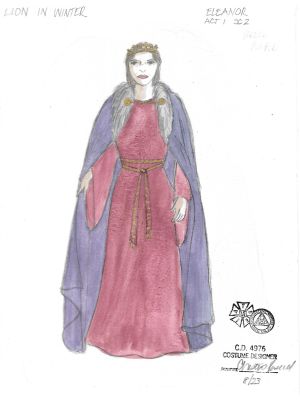
While these costumes are simple shapes, the fabrics are velvet, silk, wool, and linen. The look is Succession – it’s quiet luxury. Everything is in the fiber content and how the garment feels. The costumes are trimmed with fur, leather, and silk and other natural materials that elevate them to something royal. I also wanted that reflected in the colors; I didn’t want everything to be gray or monotone.
When these characters come onstage, they’re making entrances. They’re all royalty and I want the costumes to have that same impact and enhance that storytelling.
The Lion in Winter runs from November 3 – December 3, 2023. Make yourself at home in King Henry’s castle → Get Tickets